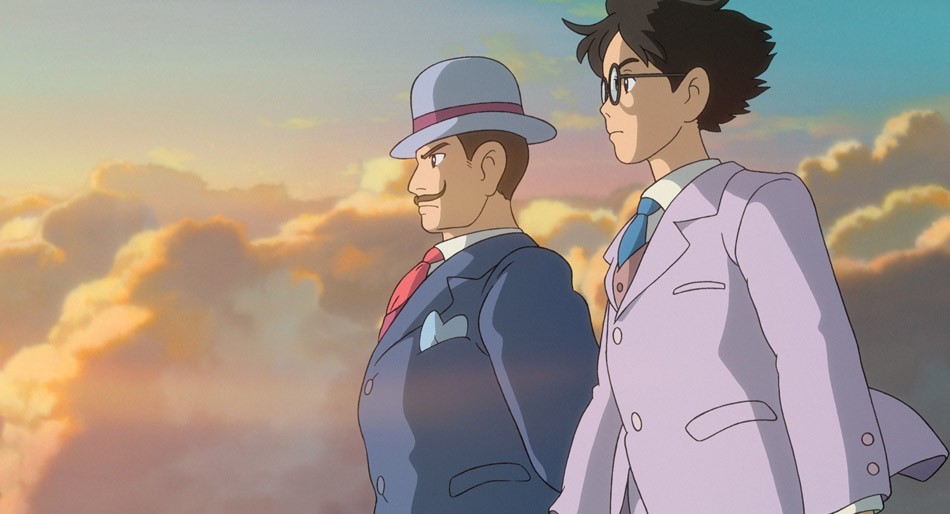When legendary Japanese director Hayao Miyazaki announced in September of last year that "The Wind Rises" was to be his final film, it was hard not to feel a sadness at what audiences would be losing without any more of his imaginative, lushly animated films. True, the director has promised retirement several times in the past, only to eventually reconsider. Visually stunning and morally complex, his supposedly final film is a fantastic achievement. If it does turn out that his retirement sticks this time, "The Wind Rises" would make for a fitting end to a remarkable career. Though the film contains none of the more fantastical elements that the filmmaker behind "My Neighbor Totoro" and "Spirited Away" is known for, it's clear that the story he's telling is a deeply personal one. There's a wistful, occasionally mournful finality to the film that feels very much like a farewell.

- PHOTO COURTESY TOUCHSTONE PICTURES
- Mr. Caproni and Jiro Horikoshi in “The Wind Rises.”
"The Wind Rises" tells a fictionalized version of the life story of Japanese aeronautics engineer JiroHorikoshi. As a child at the dawn of the 20th century, he dreams of flying, but his poor eyesight prevents him from becoming a pilot. He decides that if he can't fly planes, then he's going to make a career out of designing them instead. He's a genius engineer, always looking for ways to improve his work and create beautiful aircrafts, like the ones he sees in his dreams. Jiro lands a job working for the Mitsubishi corporation, and it's there that his obsessive pursuit of perfection ultimately leads him to design the A6M Zero bombers used by the Japanese army during World War II, most infamously in their attack on Pearl Harbor.
Miyazaki's film has not been without controversy, with a number of critics accusing the film of whitewashing history by glossing over the deadly results of Jiro's work. But to make that argument seems to miss the point of the film entirely. The conflict at the heart of the film is whether or not realizing one's dreams is worth it, if the results will cause harm to a great many people. Jiro is a genius who wants nothing more than to create something beautiful. The rising tide of war creeps around the edges of his life; he's always aware of it, and knows how his work is being put to use. But he chooses to focus on the beauty and purity of his creations instead of the destruction they'll bring.
Miyazaki's film most clearly lays out these ideas during several dream sequences, as Jiro imagines himself in conversation with his boyhood idol, Italian engineer Giovanni Caproni. It's Caproni who tells Jiro early on that "the dream of aviation is cursed," with the wonder of flight constantly being perverted and twisted into something that's so often used for evil. It's hard not to flash back to those indelible images of 9/11 and realize how much truth there is in that statement. It's in these dreams that we're allowed to see the inner conflict Jiro keeps suppressed. "I choose to live in a world with pyramids," Caproni says, with the implication being that those wonders wouldn't have been made without the manpower of an enslaved people.
As with the similar criticisms raised against Martin Scorsese's "The Wolf of Wall Street" -- that that film was glorifying the depraved behavior of its characters -- people seem to have a problem when directors opt not to spell out for audiences exactly how they should feel. The film depicting the ways in which Jiro willingly puts blinders on when it comes to how his creations are being utilized in the real world is very different from Miyazaki himself ignoring those effects. Miyazaki is above all a humanist; he doesn't ask us to agree with Jiro, but he does attempt to get us to understand him. The director's work has always contained strong environmentalist and anti-war messages, and "The Wind Rises" is no different.
The last third of the film shifts gears slightly, allowing a love story that's introduced early in the film to gradually take center stage. Jiro develops a relationship with a young woman named Naoko. Jiro learns that Naoko has tuberculosis, and though that doesn't stop the two from falling in love, Jiro remains focused on his work even as her sickness progresses. The love story feels underdeveloped, but it's easy to see how Jiro's tunnel vision allowing his career to trump his personal life may have personal resonance with the Miyazaki.
The version of the "The Wind Rises" playing in American theaters is dubbed in English and produced by Disney. As with the American releases of many of Miyazaki's previous films, the dubbing process was overseen by John Lasseter, Pixar's chief creative officer, and it is impeccably done. The American vocal cast includes Joseph Gordon-Levitt, John Krasinski, and Emily Blunt, and while they all contribute fine work, they also have recognizable voices. That occasionally distracts, as viewers try to mentally place whose voice they're hearing.